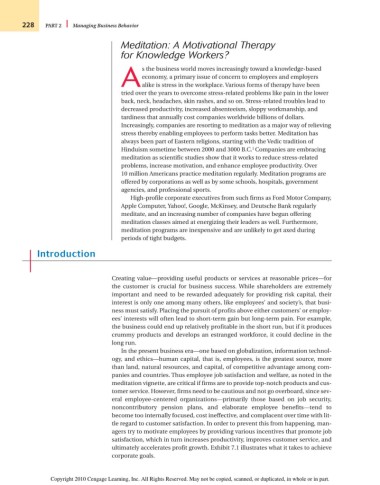Page 254 - Introduction to Business
P. 254
228 PART 2 Managing Business Behavior
Meditation: A Motivational Therapy
for Knowledge Workers?
s the business world moves increasingly toward a knowledge-based
economy, a primary issue of concern to employees and employers
A alike is stress in the workplace. Various forms of therapy have been
tried over the years to overcome stress-related problems like pain in the lower
back, neck, headaches, skin rashes, and so on. Stress-related troubles lead to
decreased productivity, increased absenteeism, sloppy workmanship, and
tardiness that annually cost companies worldwide billions of dollars.
Increasingly, companies are resorting to meditation as a major way of relieving
stress thereby enabling employees to perform tasks better. Meditation has
always been part of Eastern religions, starting with the Vedic tradition of
1
Hinduism sometime between 2000 and 3000 B.C. Companies are embracing
meditation as scientific studies show that it works to reduce stress-related
problems, increase motivation, and enhance employee productivity. Over
10 million Americans practice meditation regularly. Meditation programs are
offered by corporations as well as by some schools, hospitals, government
agencies, and professional sports.
High-profile corporate executives from such firms as Ford Motor Company,
Apple Computer, Yahoo!, Google, McKinsey, and Deutsche Bank regularly
meditate, and an increasing number of companies have begun offering
meditation classes aimed at energizing their leaders as well. Furthermore,
meditation programs are inexpensive and are unlikely to get axed during
periods of tight budgets.
Introduction
Creating value—providing useful products or services at reasonable prices—for
the customer is crucial for business success. While shareholders are extremely
important and need to be rewarded adequately for providing risk capital, their
interest is only one among many others, like employees’ and society’s, that busi-
ness must satisfy. Placing the pursuit of profits above either customers’ or employ-
ees’ interests will often lead to short-term gain but long-term pain. For example,
the business could end up relatively profitable in the short run, but if it produces
crummy products and develops an estranged workforce, it could decline in the
long run.
In the present business era—one based on globalization, information technol-
ogy, and ethics—human capital, that is, employees, is the greatest source, more
than land, natural resources, and capital, of competitive advantage among com-
panies and countries. Thus employee job satisfaction and welfare, as noted in the
meditation vignette, are critical if firms are to provide top-notch products and cus-
tomer service. However, firms need to be cautious and not go overboard, since sev-
eral employee-centered organizations—primarily those based on job security,
noncontributory pension plans, and elaborate employee benefits—tend to
become too internally focused, cost ineffective, and complacent over time with lit-
tle regard to customer satisfaction. In order to prevent this from happening, man-
agers try to motivate employees by providing various incentives that promote job
satisfaction, which in turn increases productivity, improves customer service, and
ultimately accelerates profit growth. Exhibit 7.1 illustrates what it takes to achieve
corporate goals.
Copyright 2010 Cengage Learning, Inc. All Rights Reserved. May not be copied, scanned, or duplicated, in whole or in part.

